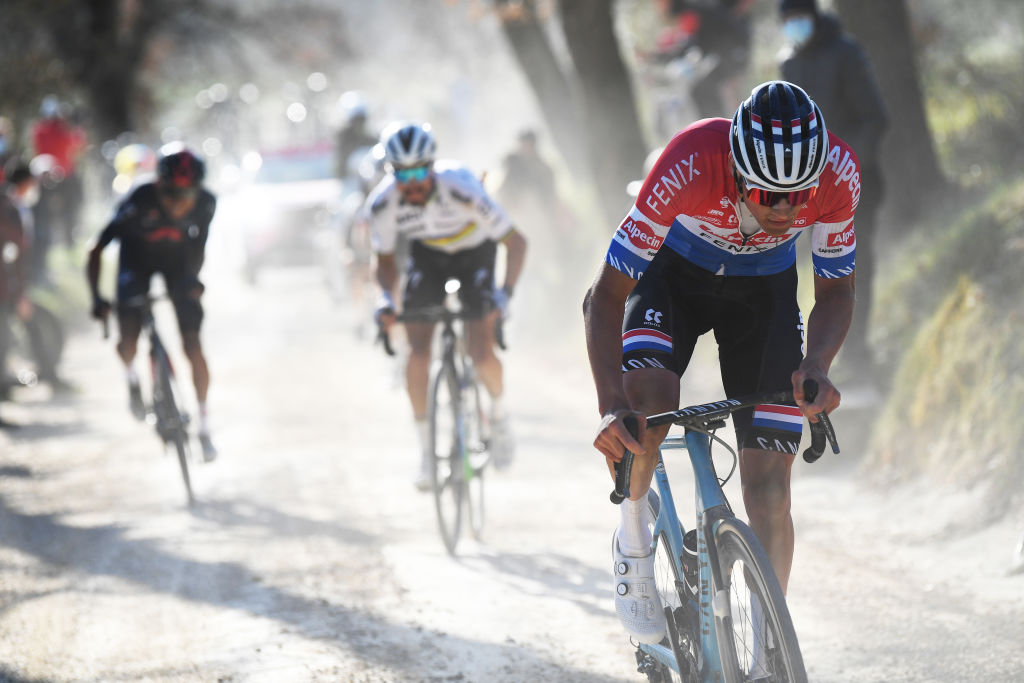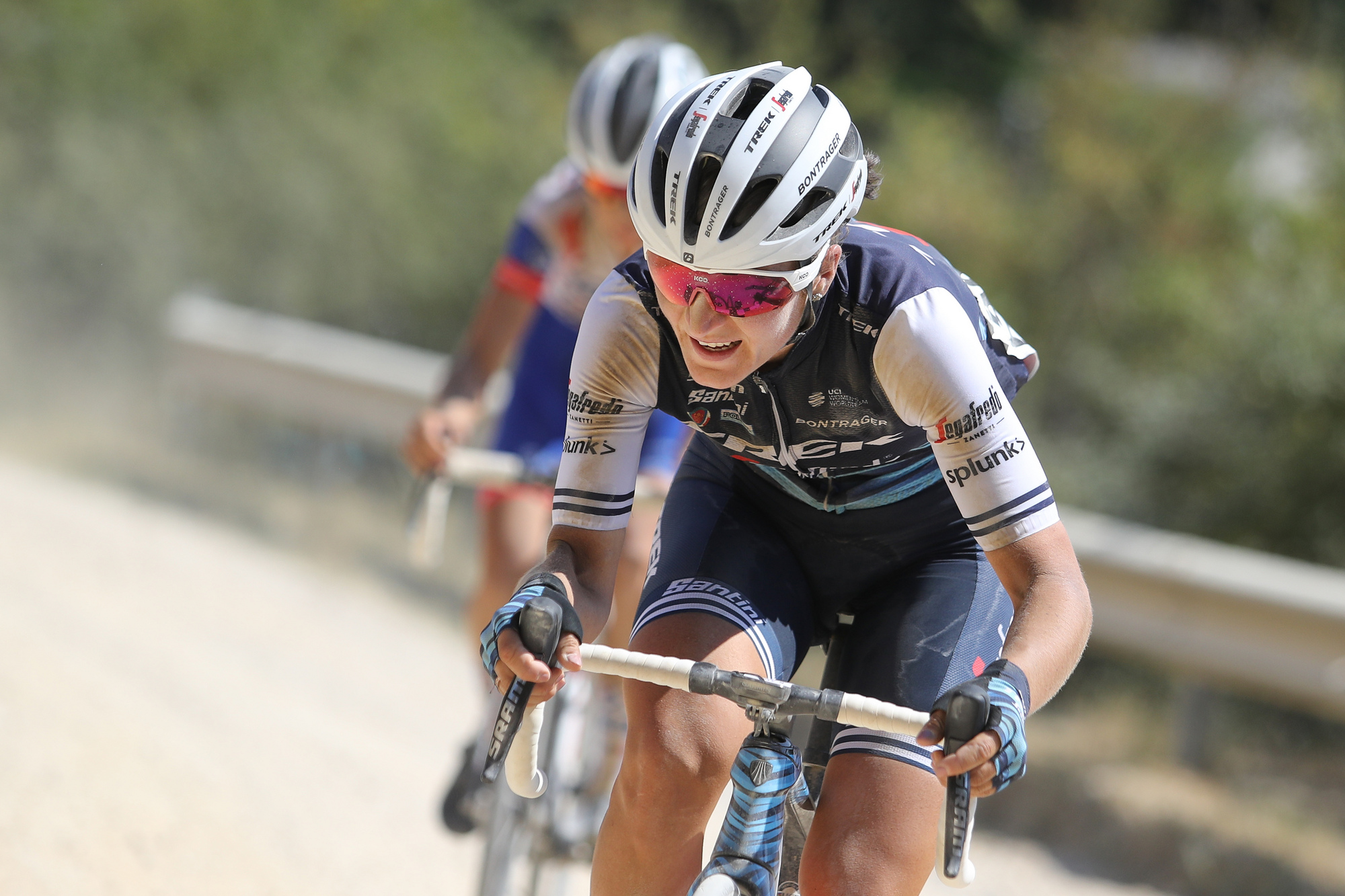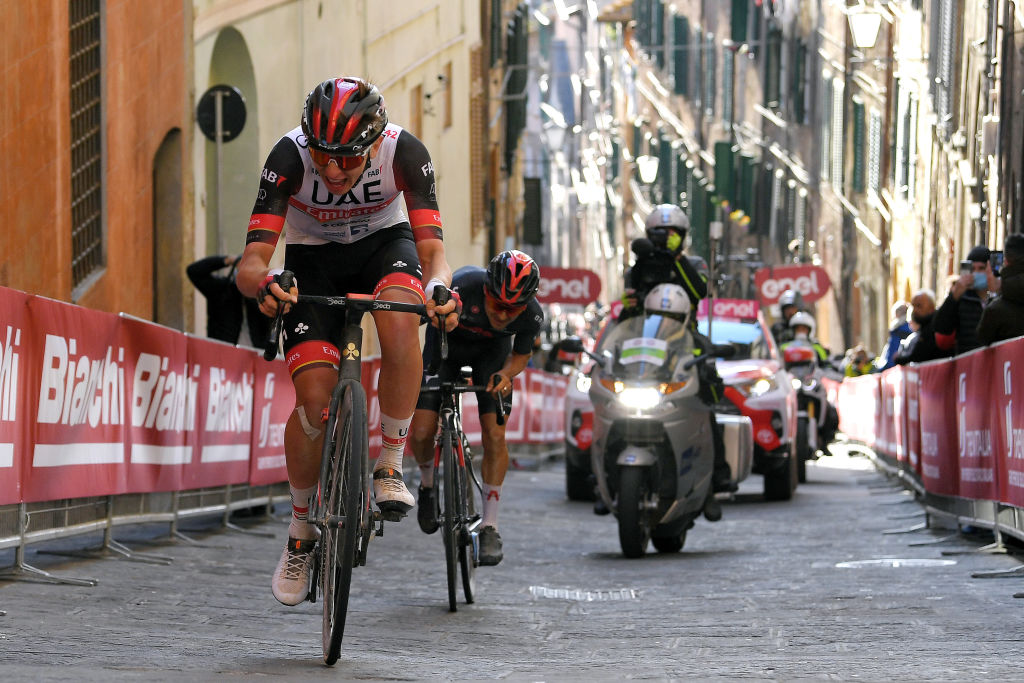The secrets of Strade Bianche - where the attacks will come
Understanding the gravel roads and the final steep climb up to the finish in Siena

Strade Bianche is like no other race, which is why it has become so prestigious in just 16 years, with some suggesting it be nominated as the sport's sixth Monument.
Riders love to race Strade Bianche whatever their form, their gravel ability, the weather and result on the day.
Last year L’Equipe asked professional riders to pick their race favourites on the calendar, with many choosing Strade Bianche and saying it should be the sport's sixth Monument.
The Strade Bianche route and Tuscan 'strade bianche' gravel sectors remind many of Paris-Roubaix and the rough-road races of old, yet the Tuscan hills south of Siena are like those of the Ardennes: short, often very steep and painful to ride at race speed. Together the climbs and the gravel roads create a unique race that is suited not only to the best Classics riders but also the Grand Tour climbers.
This is reflected in the challengers for each year's race. Last year two-time Tour de France winner Tadej Pogačar (UAE Team Emirates) dominated Strade Bianche with a 50km solo attack. In 2021 Mathieu van der Poel fought with Julian Alaphilippe and Egan Bernal.
In the 2022 women's race Lotte Kopecky (SD Worx) beat Annemiek van Vleuten (Movistar) while Elisa Longo Borghini (Trek-Segafredo) has long been a contender.
Strade Bianche was inspired by the L’Eroica vintage bike ride that covers many of the same gravel roads and recalls the heroes of the origins of road racing, when unpathed roads were commonplace.
The latest race content, interviews, features, reviews and expert buying guides, direct to your inbox!
The same Tuscan climbs and dirt roads now inspire attacks and spark selections before the final climb to the centre of Siena and the final turn into Piazza del Campo often decides the winner.
The secret to winning Strade Bianche is knowing how to ride on the dirt roads, the ability to make repeated efforts on the many climbs and then having the power to blast up the Via Santa Caterina to central Siena with a final effort that distances your rivals.
Cyclocross and gravel riding skills can play a huge part in avoiding punctures and crashes and holding position in the stretched out peloton, while raw power can open a gap on the final climb.
Wout van Aert realised the leg-sapping effect of Via Santa Caterina in 2018 when he came to a standstill near the top and then struggled to get back in the saddle. However, it was a lesson learned for 2020 when he dominated the race with a solo attack on the final dirt sector and then danced to victory at the finish in Siena.
In 2021 Mathieu van der Poel attacked on the steep final sector of dirt roads and then again on the steep climb to the finish to distance Julian Alaphilippe and Egan Bernal. In 2022 Pogačar was on fire and blasted away from his rivals and was only seen again on the podium overlooking the central Piazza del Campo.
This year’s favourites would do well to watch their performance and learn the secrets of racing Strade Bianche.
The decisive final three sectors of Strade Bianche
This year’s men’s race includes the same 63 kilometres of white gravel roads spread across the 11 sectors of the 184-kilometre race as past years. The women’s race covers 136km, including eight gravel sectors for a total of 31.6km.
The women’s race avoids the southernmost part of the men’s route near Montalcino but includes the decisive late sections that inspire the final attacks.
The earlier sectors are close to 10 km in length, making a gradual natural selection as they dip and roll over the exposed Tuscan hills.
The San Martino in Grania sector is 9.5km long, starts with 73km left to race and often kicks off the finale of both races. It is soon followed by the spectacular Monte Santa Marie sector that is a testing 11.5km long. Only those who have avoided the time-sapping punctures and crashes and are left in the front group at this point, with 43km to go, will go on to fight for victory.
This is one of the most iconic sections of the Strade Bianche @CA_Ita. The road climbs, the gradient gets into double figures and the race explodes! ⬇️📍 Monte Sante Marie - ⭐️⭐️⭐️⭐️⭐️📏 Length - 11.5 km⛰ Uphill - 4.5 km😱 Maximum gradient 18%#StradeBianche pic.twitter.com/GK6gvqhcPsFebruary 14, 2023
The Montaperti sector comes with just 24km left to race and is the first of the final three short but steep sectors of dirt road. It is only 800 metres long but includes double-digit gradients and is a perfect place to launch an attack.
Afterwards, a short, road descent passes through Vico d’Arbia and Pieve a Bozzone to the east of Siena to the Colle Pinzuto sector. A right through the trees leads to the foot of the first, steep section of the climb, with several hairpins easing the gradient but also creating loose gravel.
The gradients ease as the views across the hilltops emerge but the dirt road continues to climb for a total of 2.4km. The descent only starts after the San Giorgio a Lapi winery.
A fast, country road leads to the final dirt sector called Le Tolfe. It is only 1.1km long but has a section at 18 per cent, offering another place to make an attack just as van der Poel did in 2021. Le Tolfe ends near a hilltop chapel. Siena is visible across the vineyards and is little more than 12km away.
This is the time for the decisive pedal stroke. This is the time to dream of Piazza del Campo with arms raised. This is the time to attack, without looking back ⬇️📍 Colle Pinzuto - ⭐️⭐️⭐️⭐️📏 Length - 2.4 km⛰ Uphill - 2.5 km😱 Maximum gradient 15%#StradeBianche pic.twitter.com/EeQyU2WISYFebruary 22, 2023

Not built for bikes
The strade bianche are, like the cobbled roads of northern France or those in Flanders, country roads that have escaped being asphalted. They connect tiny villages, hilltop farms, olive groves and vineyards.
They weren’t built for cars and they especially weren't built for bikes, with the gradients more suited to tractors, SUV's or rugged Fiat Panda cars.
The strade bianche are used by local residents and farmers to cut across the hills. Their tyres often causing humps in the middle of the road and gravel filled channels on each side. The local authorities usually fill in the biggest potholes that are formed by rain before the races, but others remain and are often in the centre of the tyre tracks, perfect traps for a snake-bite puncture.
The infrequent traffic and occasional heavy rain means some gradual corners are left with a series of ripples that create a scary washing board vibration when ridden at speed. Stones of every dimension can be left on the surface and ping sideways when hit by a wheel. Taking the right line on the strade bianche is as vital as when riding the cobbles during Paris-Roubaix.
Cyclingnews studied the final sectors to get a real feel for the conditions the riders will face on Saturday.
The Tuscan winter has again been mild but mainly dry in recent weeks. Rain on Wednesday helped to dampen the dust but the winter always leaves its mark as riders will realise during final reconnaissance on Thursday and Friday.
The Strade Bianche mud will be more light-brown coloured than bone dry and bianche (white).
Choosing the best line on the dirt roads is vital but riding on a wheel makes it virtually impossible to see what is ahead, hence the peloton becomes lined out. Losing position up front can end a race in a split second.
The climbers would no doubt like to dance on the pedals on the steepest ascents. However, taking weight off the rear wheel sparks a loss of traction and can lead to wheel slips. The best way to go up the climbs is to grind round the pedals at a decent cadence while staying firmly seated on the saddle.
Tyre choice is important and going tubeless could help avoid punctures. Most riders opt to use their standard road race bike fitted with slightly wider tyres – perhaps 28mm – and running lower pressure. If the roads are dry, disc brakes offer few advantages and could mean slower wheel changes.
Bike handling, muscle strength and fitness will make the biggest difference on the day.
The climb to the finish in Siena

When the dirt roads end with 12km to go, Strade Bianche is far from over.
Siena’s magnificent towers and red brick buildings can be seen from the surrounding hilltops but that means there is still the final climb to the finish.
Most major roads circulate around the city to ease the gradients but the Strade Bianche follows the Strada di Fontebranda to the foot of the city and then goes straight up the narrow and steep Via Santa Caterina.
A chicane marks the start of the final ramp with large stone slabs and a rough surface to provide grip. That makes the 10 per cent gradient feel even steeper, with a gradual ramping up taking it to 16 per cent. The right turn onto flat roads in the city centre offers welcome respite and comes just 500 metres from the finish but the Via Santa Caterina produces a final moment of pain.
The Italian tifosi usually pack behind the barriers and cheer on the riders at the top of Via Santa Caterina, some sadistically capturing their suffering to post on social media. Siena was in lockdown last year but the crowds and race photographers will be back this time.
The first rider to the top of Via Santa Caterina often wins Strade Bianche because positioning is key on the final descending road through Siena. As the road eases on the city streets, there is a final chance to move up to the front but it takes guts, a strong late sprint effort and good brakes to avoid crashing on the last right turn into Piazza del Campo.
Whoever makes it first into the corner can celebrate as they descend to the finish line at the lowest point of the stunning square outside the ancient town hall building and tower.

Stephen is one of the most experienced members of the Cyclingnews team, having reported on professional cycling since 1994. Before becoming Editor-at-large, he was Head of News at Cyclingnews. He has previously worked for Shift Active Media, Reuters and Cycling Weekly. He is a member of the Board of the Association Internationale des Journalistes du Cyclisme (AIJC).
